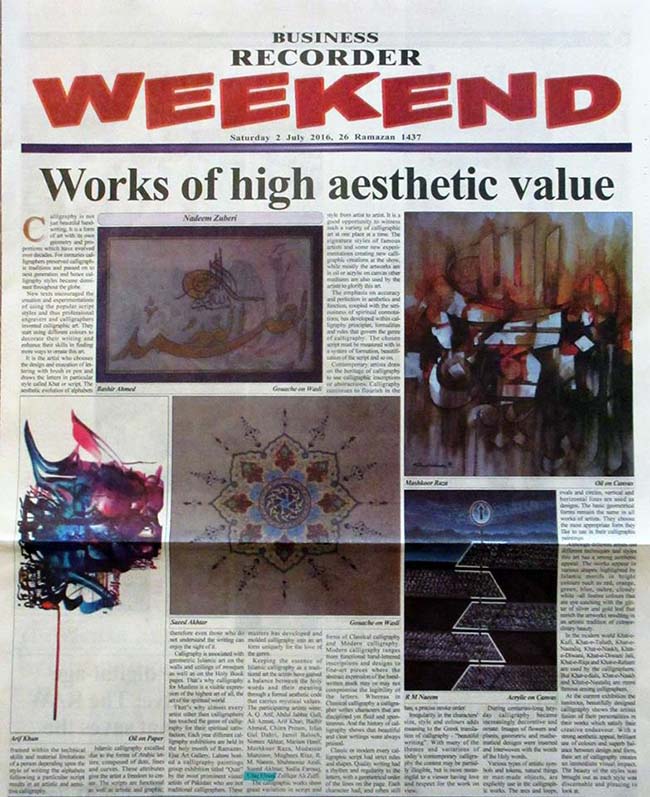Calligraphy is not just beautiful handwriting. It is a form of art with its own geometry and proportions which have evolved over decades. For centuries calligraphers preserved calligraphic traditions and passed on to next generation and hence calligraphy styles became dominant throughout the globe.
New texts encouraged the creation and experimentations of using the popular script styles and thus professional engravers and calligraphers invented calligraphic art. They start using different colours to decorate their writing and enhance their skills in finding more ways to ornate this art.
It is the artist who chooses the design and execution of lettering with brush or pen and draws the letters in particular style called Khat or script. The aesthetic evolution of alphabets framed within the technical skills and material limitations of a person depending upon the style of writing the alphabets following a particular script results in an artistic and sensitive calligraphy.
Islamic calligraphy excelled due to the forms of Arabic letters, composed of dots, lines and curves. These attributes give the artist a freedom to create. The scripts are functional as well as artistic and graphic; therefore even those who do not understand the writing can enjoy the sight of it.
Calligraphy is associated with geometric Islamic art on the walls and ceilings of mosques as well as on the Holy Book pages. That’s why calligraphy for Muslims is a visible expression of the highest art of all, the art of the spiritual world.
That’s why almost every artist other than calligraphers has touched the genre of calligraphy for their spiritual satisfaction. Each year different calligraphy exhibitions are held in the holy month of Ramazan. Ejaz Art Gallery, Lahore hosted a calligraphy paintings group exhibition titled “Quat” by the most prominent visual artists of Pakistan who are not traditional calligraphers. These masters has developed and molded calligraphy into an art form uniquely for the love of the genre.
Keeping the essence of Islamic calligraphy as a traditional art the artists have gained a balance between the holy words and their meaning through a formal aesthetic code that carries mystical values. The participating artists were: A. Q. Arif, Abdul Jabbar Gull, Ali Azmat, Arif Khan, Bashir Ahmed, Chitra Pritam, Irfan Gul Dahri, Jamil Baloch, Noreen Akhtar, Mariam Hanif, Mashkoor Raza, Mudassar Manzoor, Mughees Riaz, R. M. Naeem, Shahnawaz Azidi, Saeed Akhtar, Sadia Farooq, Ufaq Ehsan, Zulfiqar Ali Zulfi.
The calligraphic works show great variation in script and style from artist to artist. It is a good opportunity to witness such a variety of calligraphic art at one place at a time. The signature styles of famous artists and some new experimentations creating new calligraphic creations at the show, while mostly the artworks are in oil or acrylic on canvas other mediums are also used by the artists to glorify this art.
The emphasis on accuracy and perfection in aesthetics and function, coupled with the seriousness of spiritual connotations, has developed within calligraphy principles, formalities and rules that govern the genre of calligraphy. The chosen script must be measured with in a system of formation, beautification of the script and so on.
Contemporary artists draw on the heritage of calligraphy to use calligraphic inscriptions or abstractions. Calligraphy continues to flourish in the forms of Classical calligraphy and Modern calligraphy. Modern calligraphy ranges from functional hand-lettered inscriptions and designs to fine-art pieces where the abstract expression of the handwritten mark may or may not compromise the legibility of the letters. Whereas in Classical calligraphy a calligrapher writes characters that are disciplined yet fluid and spontaneous. And the history of calligraphy shows that beautiful and clear writings were always praised.
Classic or modern every calligraphic script had strict rules and shapes. Quality writing had a rhythm and regularity to the letters, with a geometrical order of the lines on the page. Each character had, and often still has, a precise stroke order.
Irregularity in the characters’ size, style and colours adds meaning to the Greek translation of calligraphy – “beautiful writing”. With many of the themes and variations of today’s contemporary calligraphy the content may be partially illegible, but is more meaningful to a viewer having love and respect for the work on view.
During centuries-long heyday calligraphy became increasingly decorative and ornate. Images of flowers and plants, geometric and mathematical designs were inserted and interwoven with the words of the Holy words.
Various types of artistic symbols and tokens, natural things or man-made objects, are explicitly use in the calligraphic works. The arcs and loops, ovals and circles, vertical and horizontal lines are used as designs. The basic geometrical forms remain the same in all works of artists. They choose the most appropriate form they like to use in their calligraphic paintings.
Although different artists use different techniques and styles this art has a strong aesthetic appeal. The works appear in various shapes, highlighted by Islamic motifs in bright colours such as red, orange, green, blue, ochre, cloudy white –all festive colours that are eye catching with the glitter of silver and gold leaf that enrich the artworks resulting in an artistic tradition of extraordinary beauty.
In the modern world Khat-e-Kufi, Khat-e-Tuluth, Khat-e-Nastaliq, Khat-e-Naskh, Khat-e-Diwani, Khat-e-Diwani Jali, Khat-e-Riqa and Khat-e-Reham are used by the calligraphers. But Khat-e-Suls, Khat-e-Naskh and Khat-e-Nastaliq are more famous among calligraphers.
At the current exhibition the luminous, beautifully designed calligraphy shows the artists fusion of their personalities in their works which satisfy their creative endeavour. With a strong aesthetic appeal, brilliant use of colours and superb balance between design and form, their art of calligraphy creates an immediate visual impact. The beauty of the styles was brought out as each style was discernable and pleasing to look at.
